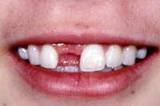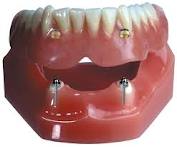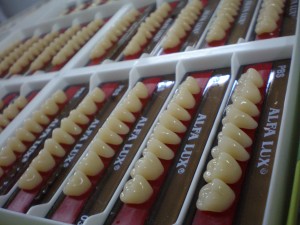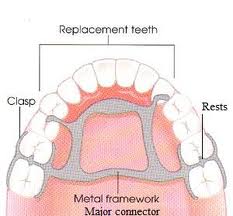Dentures come at a high price and must be properly taken care of so they last a long time. Dentures today have the look and feel of your natural teeth. Unfortunately, they are not your natural teeth and it can be hard to give up foods and snacks that you used to be able to freely enjoy. Things like gum can cause big problems for denture wearers. If gum gets stuck on your dentures, do not worry. You can remove gum from dentures yourself with a little effort. Continue reading
Category Archives: Denture
How to Recycle Partial Dentures
It’s time to replace your partial dentures. But what do you do with your old ones? It seems a shame to just throw them away. After all, they were expensive, and there are so many people who can’t afford dentures but need them. Did you know that there are over 3,600,000 sets of dentures produced around the world every year? And did you know that each set contains around roughly US$25 of precious metals? Unfortunately, because of the personalized nature of dentures, they are usually not recycled in such a way that they are given to another person to wear. There are some things, however, that you can do with your partial dentures other than just tossing them in the nearest trash bin. Continue reading
Understanding The Use of Partial Dentures in Children
Partial dentures are often associated with the elder age group, to replace permanent teeth that have been extracted. However, in some situations children are also required to wear partial dentures.
Reasons for loss of teeth in children:
Continue reading
How to Evaluate Denture Occlusion
Denture occlusion is no different from natural teeth occlusion. Occlusion refers to your bite, to how well and how accurate the teeth come together and how well the top teeth fit into the bottom teeth when you bite together. If you experience pain when you bite down or chew food, your occlusion may be off and need adjustment. You evaluate denture occlusion the same way you evaluate natural teeth occlusion, with dental occlusion paper and a mouth mirror available from your dentist or a dental supply laboratory. Continue reading
How to Kiss With a Partial Denture
Wearing dentures can take a bit of practice, especially when it comes to inserting them and taking them out. Most people will adapt to dentures relatively easily, however, with just a bit of practice. You’ll also find that most normal activities, like speaking and eating, even whistling, can be done with dentures as well. Kissing with dentures is essentially the same as kissing without them. If you’re feeling nervous about the idea, there are a few things you can do to help relieve your anxiety and ensure a pleasant experience for all concerned. Continue reading
What Are Magnetic Dentures?
Introduction
An overdenture is a partial or complete denture that are supported by one or more remaining natural teeth or implants; these supporting teeth or implants are called “abutmentsâ€. The overdenture may be attached to the abutments by 2 means: mechanical (ball and bar attachments) and magnetic attachment. Overdentures with magnetic attachments are called “Magnetic dentures“. Magnets have become very popular as retainers since the 1950’s. According to The Times, in 1957, a Cornell University Medical College professor developed a denture that was held in place by embedding powerful magnets in the patients jaw bone. The magnets were made from aluminum–nickle–cobalt (AlNiCo) alloys. However, this means of achieving retention had limited success, as they were associated with a few problems:
Hard Vs. Soft Denture Reline
Denture fitting is so crucial to comfortable use that a slight misalignment can create many far-reaching problems in your mouth. Due to the nature of gums, dentures need adjustments from time to time to properly fit. Gums and jawbone shrink with time as part of the natural aging process. Dentures that may have fit perfectly at first can become unsuitable for chewing as they loosen and slide around. Two types of adjustments are available: hard reline and soft reline. Both types of relines can either be performed in office or by using a do-it-yourself denture reline kit. Continue reading
Porcelain Vs. Acrylic Teeth
Artificial teeth used to make dentures can be made of porcelain, acrylic resin, or composite resin. Here we will be looking at the most commonly used ones-porcelain teeth and acrylic resin.
Let’s first look at the requirements of good artificial teeth: Continue reading
What Is a Rest on a Partial Denture?
A partial denture consists of the following parts:
- Major connector-the main body of a denture which provides rigidity and unites all the parts of the denture
- Minor connector-connects all other parts of a denture to the major connector
- Denture base-the part that is adapted to the soft tissues in the region of missing teeth and will be used to support the fake teeth.
- Artificial teeth– replace missing teeth
- Direct retainer-parts of the denture that prevents the denture from dropping out of the mouth. Clasps are often used as a direct retainer.
- Indirect retainer-parts of the denture that prevents the denture from rocking or shifting sideways or rotating during eating or talking, eg: rests.
We will be focusing on rests in this article.
Continue reading
Denture Adhesives Containing Gantrez
Denture adhesives augment the same retentive mechanisms already operating when a denture is worn. They enhance retention through optimizing interfacial forces by: 1) increasing the adhesive and cohesive properties and viscosity of the medium lying between the denture and its basal seat; and 2) eliminating voids between the denture base and its basal seat. Adhesives (or, more accurately, the hydrated material that is formed when an adhesive comes into contact with saliva or water) are agents that stick readily to both the tissue surface of the denture and to the mucosal surface of the basal seat. Furthermore, since hydrated adhesives are more cohesive than saliva, physical forces intrinsic to the interposed adhesive medium resist the pull more successfully than would similar forces within saliva. The material increases the viscosity of the saliva with which it mixes, and the hydrated material swells in the presence of saliva/water and flows under pressure. Voids between the denture base and bearing tissues are therefore obliterated. Continue reading



